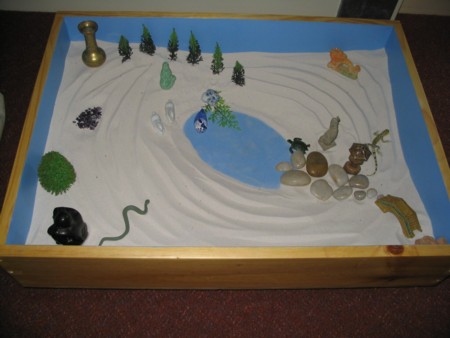|
SANDPLAY THERAPY
A large part of our work is training in Sandplay Therapy and Symbol Work, particularly for those involved in working with children who have difficulties.
'Thank you for the introduction to Sandplay. The gentle way you as facilitators approached our learning, I believe, had a huge impact on how excited I am to have knowledge of this therapy. I have used it with a few of my young clients and the impact it has had on them is incredible'.
Carol Long,
Centacare, Mt Isa.

'Carl Jung (1964) stated that no textbook can teach psychology; one learns only by actual experience. Completing the training in Expressive Therapies provided an experiential learning environment that assisted me to reconnect with my intuitive wisdom which now guides my academic knowledge in my psychological practice.'
Carol Farnell (B.Psyc.(Hons), B.Beh.Sc., Grad.Dip.Ad.Voc.Ed)
Sandplay Therapy has a background of over 75 year's theoretical, clinical and practical application. It is considered one of the most effective and probably the safest therapeutic modality and is used by many counsellors and psychologists as a major extension or alternative to cognitive therapies among children, adolescents and adults.
In the Jungian tradition, a basic premise of the therapy is that deep in the unconscious the psyche has a natural ability to heal itself which is instinctual if left free to operate naturally in a protected environment. It is the therapist's and client's mutual trust in the client's innate inner guidance that allows it to work.
The method of Sandplay we use has been developed from the work of Dr Margaret Lowenfeld and Dora Kalff. (See 'Introduction to Sandplay Therapy' by Dora M Kalff below).
We combine both Jungian and Gestalt approaches to working with symbolic objects in a sandtray. Sandplay can help resolve personal problems, reclaim forgotten qualities and open the individual to their own inner guidance. Sandplay allows a client to open up whatever issues or concerns are most urgent in the psyche, without planning or necessarily having cognitive clarity at the start. This is another reason the process is so effective with children.
The teachers, guidance officers, counsellors, social workers and child-care workers and psychologists who use this with children with difficulties comment in the most direct terms as to its effectiveness, non-intrusiveness and safety.
The following three articles, 'Sandplay with Children', 'Sandplay in Trauma Healing' and 'An Introduction to Sandplay Therapy' are an excellent basis for an understanding of the value and application of sandplay therapy
SANDPLAY WITH CHILDREN
Kay Bradway
Kay Bradway, Ph.D., JA, is a founding member of Sandplay Therapists of America and the International Society for Sandplay Therapy. She is a psychologist and Jungian analyst in Sausalito, California.
Sandplay has an accelerating history. It goes back to an early decade of the last century when H.G. Wells wrote about his observing his two sons playing on the floor with miniature figures and his realizing that they were working out their problems with each other and with other members of the family. Twenty years later Margaret Lowenfeld, child psychiatrist in London, was looking for a method to help children express the "inexpressible." She recalled reading about Wells' experience with his two sons and so she added miniatures to the shelves of the play room of her clinic. The first child to see them took them to the sandbox in the room and started to play with them in the sand. And thus it was a child who "invented" what Lowenfeld came to identify as the World Technique (Lowenfeld, 1979).
Read more here. SANDPLAY WITH CHILDREN Kay Bradway)
SANDPLAY IN TRAUMA HEALING
Elizabeth R Lyons
...Sandplay reflects commonly recognised principles of trauma healing:
Sandplay is intrinsically respectful of trauma survivors' inner wisdom and inner processes as they are in complete control of their own sandplay creations and the uniquely individual meanings of their creations. The sandplay itself is usually experienced as non-threatening and relaxing. There is no therapist agenda imposed, nor any pressure to "do" anything (just an invitation to play/create a picture). The safety of this modality can help the client create a sense of safe containment of traumatic material within the boundaries of the tray. By readily allowing for change in the representation of the inner reality, over time sandplay can also facilitate the ability to transform the experiential reality, whenever ready.
Read more here SANDPLAY IN TRAUMA HEALING. Elizabeth R Lyons
INTRODUCTION TO SANDPLAY THERAPY
Dora M. Kalff
Dora Kalff, Jungian therapist, developed sandplay therapy in Switzerland in the 1950s and '60s based on her studies at the C.G. Jung Institute, Zurich, in Tibetan Buddhism, and with Margaret Lowenfeld, in England.
Summary
The client is given the possibility, by means of figures and the arrangement of the sand in the area bounded by the sandbox, to set up a world corresponding to his or her inner state. In this manner, through free, creative play, unconscious processes are made visible in a three-dimensional form and a pictorial world comparable to the dream experience. Through a series of images that take shape in this way, the process of individuation described by C. G. Jung is stimulated and brought to fruition.
Read more here. 'INTRODUCTION TO SANDPLAY THERAPY' - Dora Kalff
|


